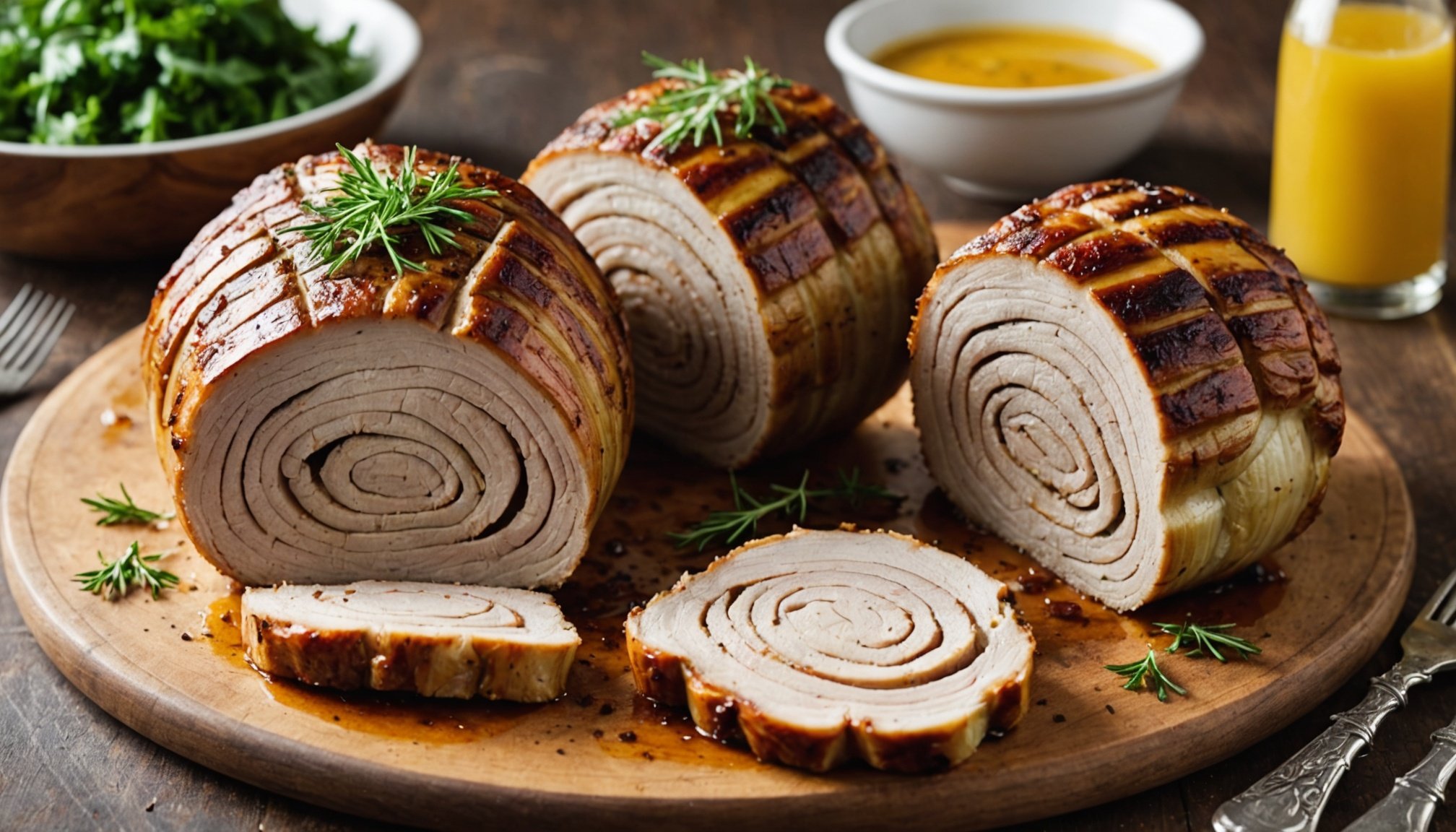Understanding Porchetta
Understanding porchetta is vital to appreciating this traditional Italian dish. Historically, porchetta holds a significant place in Italian cuisine, often associated with festive occasions and gatherings. Its origins can be traced back to the regions of Lazio and Umbria, where it was celebrated as a specialty for its robust, flavorful profile.
The traditional preparation of Italian porchetta calls for intricate culinary techniques. A whole pig or a section of it is typically deboned, stuffed with aromatic herbs such as rosemary and garlic, and then roasted. This method ensures a complex combination of textures – a crispy outer skin shielding succulent, flavorful meat beneath.
Topic to read : Unlock the secrets to making traditional english black pudding: a scrumptious fusion of oats and aromatic spices
Regional variations add diversity to this classic dish. For instance, in Ariccia, a region famous for its porchetta, the focus is on intense seasoning using wild fennel. Further north, pork loin might be used instead, contributing to the diverse palette of flavors across Italy.
Key ingredients include high-quality pork, garlic, and rosemary. Each plays a crucial role in creating the distinctive taste. The pork serves as a rich, juicy base, while herbs infuse the meat with their aromatic oils, contributing to the porchetta’s irresistible allure.
Additional reading : Deléitate con el sabor: aprende a hacer el pastel de queso manchego español ideal con gelatina de membrillo
Essential Ingredients for Perfect Porchetta
Selecting the right porchetta ingredients is crucial for achieving the perfect balance of juiciness and flavour. At the heart of this traditional dish is the selection of high-quality meat. Opting for a piece of pork with a good fat-to-meat ratio ensures that the porchetta remains moist and flavorful during cooking.
A standout ingredient in many porchetta recipes is fennel. This herb not only elevates the seasoning but also lends a unique, aromatic flavour. The fennel can be used in various forms, such as seeds or fronds, offering versatility in preparation. Including it in your pork through marination enhances the depth of taste, making it distinctly delicious.
Seasoning is another vital component when crafting a porchetta. Common spices include salt, pepper, and garlic. Besides seasoning, marinating the pork for several hours can help the spices permeate the meat, ensuring each bite is richly seasoned. Additional herbs like thyme and sage can also be used to add complexity to the flavour profile.
Quality ingredients and well-considered seasoning are key facets to consider when preparing this revered dish. The right balance transforms a simple piece of pork into a sumptuous Italian porchetta.
Step-by-Step Preparation of Porchetta
Preparing Italian porchetta involves mastering various culinary techniques to ensure a dish that’s bursting with flavour. Here’s a concise guide to the process:
Preparing the Pork
Begin with selecting a high-quality, fatty pork cut, which is essential for juicy meat. Ensure the piece is evenly flattened, which facilitates consistent cooking. Some cooks prefer a mix of pork belly and loin for varied textures.
Seasoning Techniques
The seasoning process is where the magic happens. Start by rubbing the pork with a blend of garlic, rosemary, and fennel seeds. The aim is to ensure that these flavors fully penetrate the meat. Marinating overnight is recommended for optimal depth of taste.
Rolling and Tying the Porchetta
Once seasoned, the porchetta needs to be tightly rolled. This helps keep the flavors intact and the meat juicy. Use butcher’s twine to tie the roll securely at multiple points. It’s crucial that the roll remains compact to ensure even cooking throughout.
This step-by-step approach, focusing on recipe steps and cooking techniques, helps achieve the perfect porchetta, highlighting the importance of each stage in the preparation process.
Step-by-Step Preparation of Porchetta
To master porchetta preparation, begin by focusing on the pork itself. Selection is crucial; choosing a cut with ample fat ensures flavour and juiciness. Once chosen, the pork needs careful cutting and flattening. Using a sharp knife, trim excess fat and flatten the meat evenly for optimal seasoning distribution.
Preparing the Pork
Getting the pork right starts with deboning. Lay the pork skin-side down and, using firm pressure, make incisions to flatten the meat. This step is essential for even cooking techniques later.
Seasoning Techniques
Next, infuse flavour using a mix of garlic, rosemary, and sage. Generously coat the pork, ensuring every inch is imbued with these aromatic herbs. Marinate the pork for a minimum of four hours—overnight if possible—to achieve deeper flavour penetration.
Rolling and Tying the Porchetta
Once marinated, roll the pork tightly, securing all flavor within. Use butcher’s twine to tie the roll at intervals of an inch, maintaining its shape throughout cooking. Proper rolling not only encapsulates the seasoning but also influences the final texture and appearance of this beloved traditional Italian dish.
Cooking Methods for Juicy Porchetta
Achieving a perfectly cooked porchetta involves mastering the balance between roasting and slow-cooking techniques. Both methods can yield a mouthwatering result, but each has distinct requirements. Generally, roasting provides the classic crispy skin while retaining the porchetta’s succulence. A preferred temperature for roasting is about 160°C (320°F). Slow cooking, on the other hand, tends to maintain more moisture, ideal for a melt-in-the-mouth experience.
One of the essential cooking techniques is controlling the heat. Start with a higher temperature, around 220°C (430°F), to develop the crust, then lower it to 160°C (320°F) to cook through steadily. This gradual tapering ensures meat is juicy while maintaining a golden-brown exterior. Oven techniques like using a fan-assist can help achieve even browning.
For the crispiest skin, consider air-drying the pork uncovered in the fridge before cooking. This reduces surface moisture, enhancing crispiness. Always rest the porchetta for at least 10-15 minutes post-cooking. This resting period allows the juices to redistribute, ensuring every slice remains juicy and flavourful. By paying attention to these key details, your porchetta will stand out as irresistibly delicious.
Troubleshooting Common Issues
Porchetta troubleshooting can save your dish from common cooking mistakes. Ensuring your porchetta doesn’t dry out or overcook is key. One frequent issue is lack of moisture, often due to inadequate fat content or insufficient marinating. To remedy this, always choose a cut with a good fat-to-meat ratio and allow ample marinating time.
If your porchetta turns out dry, consider drizzling it with broth or olive oil before reheating. Slow reheating at a low temperature helps retain moisture. Avoid microwaves, as they can exacerbate dryness. For those facing uneven cooking, the solution often lies with improper rolling. Ensure the roll is tight and uniform using butcher’s twine.
If achieving a crispy skin remains elusive, try increasing the oven temperature briefly at the end of cooking. Alternatively, air-drying the pork in the fridge before roasting encourages skin crispiness. If your porchetta lacks flavour, enhancing seasoning methods is crucial. Generously apply herbs like rosemary and garlic, and ensure a thorough rub. Marination is essential for deeper flavour penetration. By following these techniques, you can confidently avert mishaps and savour a perfectly prepared porchetta.
Cooking Methods for Juicy Porchetta
Achieving the perfect juicy porchetta hinges on selecting the right cooking methods. The debate often lies between roasting and slow cooking. Each offers distinct advantages. Roasting is the more traditional method. It promotes a crispy exterior while locking in moisture. Typically, the oven techniques employed focus on high temperatures at the start. This crisps the skin, followed by a lower setting to gently cook the meat through.
Recommended cooking temperatures generally range around 180°C (350°F) after the initial high heat. Cooking times vary based on porchetta size, but aim for roughly 40-45 minutes per kilogram. Monitoring internal temperature is crucial; a target of 71°C (160°F) ensures both safety and succulence.
Striking a balance for a crispy skin without moisture loss can be challenging. Here’s a tip: during the last 15-20 minutes of roasting, increase the oven temperature slightly and ensure the skin is well-aerated by removing any excess moisture beforehand. This technique aids in achieving that golden-brown, crunch-tastic outer layer.
By mastering these methods, your porchetta will be a feast of tantalising textures and flavors. This showcases the artful blend of tradition and culinary techniques.
Serving and Pairing Suggestions
When serving porchetta, it’s essential to consider traditional accompaniments that can elevate this classic Italian dish. Roasted vegetables, such as potatoes and carrots, offer a rustic touch that complements porchetta’s rich flavours. For a touch of freshness, a simple arugula salad with lemon vinaigrette balances the dish’s savoury notes.
For those seeking creative presentation, sliced porchetta can be arranged on a platter, garnished with rosemary sprigs for an aromatic finish. Serve with crusty bread to soak up any delectable juices, making the dish even more satisfying.
Sauces such as salsa verde add a zesty contrast to porchetta’s rich profile. This bright, herbaceous sauce can be drizzled over the meat or served on the side, providing a refreshing counterpart.
Beverage pairings are vital to enhancing the dining experience. Full-bodied red wines, like Chianti or Barolo, complement the depth of porchetta, while an Italian IPA offers a modern twist for those preferring beer. Alternatively, try a glass of Prosecco for a delightful counterpoint.
By thoughtfully pairing sides and drinks, you can transform your porchetta into a memorable culinary experience.











